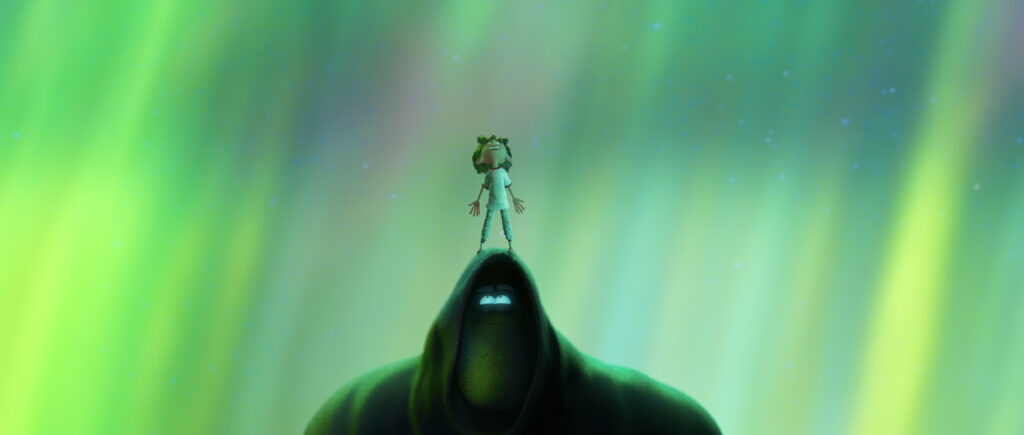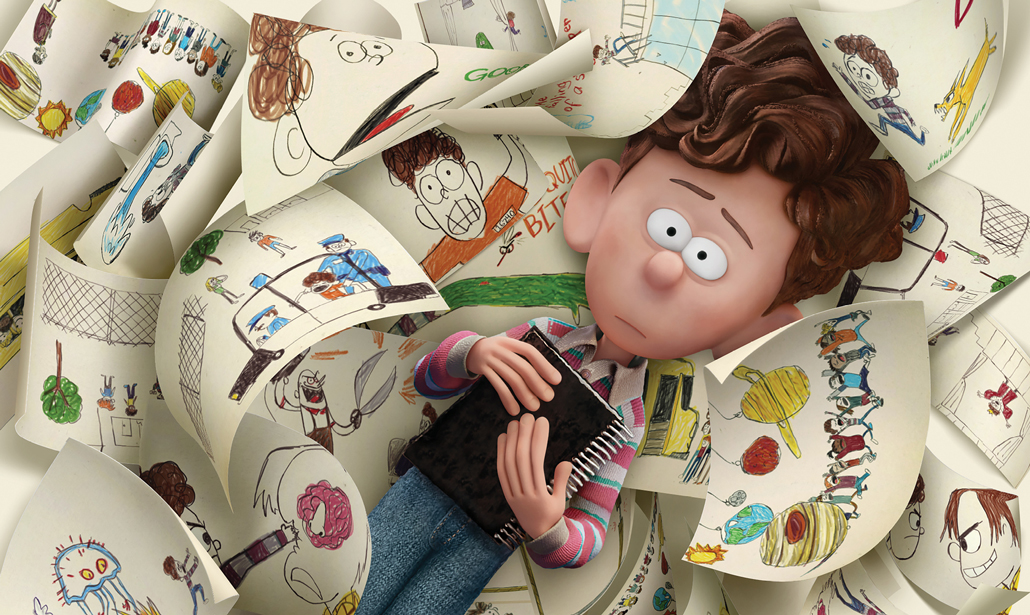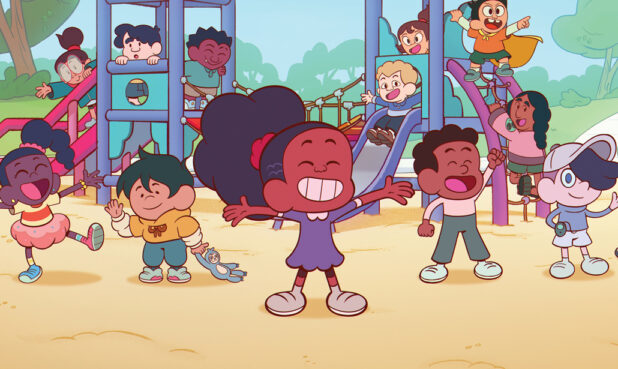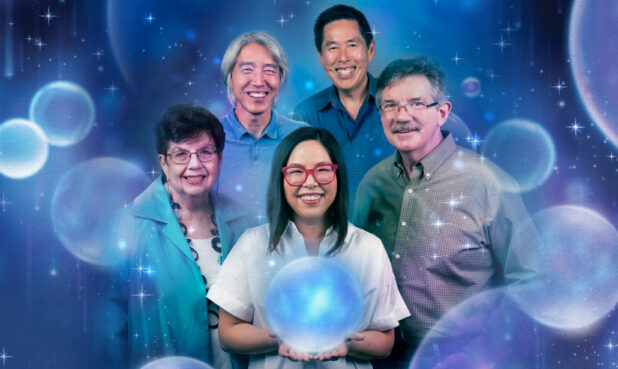From an episode touching on cognitive behavior therapy in Steven Universe to Perrito the therapy dog in the movie Puss in Boots: The Last Wish, the past decade has seen animation actively exploring mental health and the different ways it can be depicted. Words like mindfulness and intention not only help guide productions, but this language is also finding its way into storylines and dialogue. To make sure they get it right, some creators reach out to experts to ensure their shows are authentic and meaningful. And they’re allowing emotions a degree of screentime not seen in the past.
For DreamWorks newest feature film, Orion and the Dark, the story focuses on a grade school boy named Orion who feels his fear, faces it, and then befriends it—literally. Poor Orion is afraid of absolutely everything. Bullies. Clowns. Bees. Cell phone waves. Clogging his school’s toilet. But most of all, he’s afraid of the dark. Director Sean Charmatz notes that in kids movies, there seems to be a reticence to let a character stay upset for too long, but Orion is allowed to remain in a state of fear through most of the film.

Based on the children’s book by Emma Yarlett, the quirky script was written by Charlie Kaufman of Adaptation and Eternal Sunshine of the Spotless Mind fame. When darkness, in the form of an apparition named, appropriately, Dark, visits Orion, he takes the boy on a tour of the night—and as a result, a tour of his fears.
Charmatz says that as he directed the film, he drew on his own childhood experiences with anxiety and constant worry. “To break the cycle, it’s unrealistic to imagine that nothing bad is ever going to happen again,” he says. Instead, it’s important to realize your fears are just part of the ebb and flow of life, and you can’t let that affect the moment you’re in.
This is hardly typical kids’ entertainment. There’s even passing mention of nihilism, and in an extended beat, Orion floats in a kind void contemplating the greatest darkness of all—the idea of the nothingness that comes after death. The trick is to present fear without overwhelming the audience. To do this, Charmatz notes a scene where Dark has introduced Orion to the elements of the night: Sweet Dreams, Sleep, Unexplained Noises, Insomnia, and Quiet in the form of a tiny white mouse with the body of a dandelion. When Quiet demonstrates how he can remove all noise from the night, the pure silence causes Orion to have a panic attack.
“I think we got away with a lot of intense stuff because it’s so visually strange and interesting,” Charmatz says. “A little mouse dandelion sucked up all the sound, which is a wild idea. Then you throw in this real reaction. It is visceral, but Orion’s not having a panic attack because his mom and dad just got in an argument and his dad drove away, right? That to me would be too much for this movie. But because these real emotions are happening with such whimsical characters and whimsical events … you can relate, and it’s delivered in a way you’re okay with it.”
Whimsy is only one of many ways animation delivers emotions that are relatable and unthreatening, as can be seen in Stillwater. Created for pre-school and early elementary school kids, this Apple TV+ series is crafted entirely around emotional wellness. “Much like you would set an intention in terms of how you would take on any sort of task in life, we did the same thing,” says Writer and EP Rob Hoegee. “Our intention was to create a series that slowed the world down.”


Stillwater artists used texture to give Zen master panda Stillwater a soft, comforting appearance. (Stillwater images courtesy of Apple TV+.)
Stillwater is about a giant Zen master panda of the same name who lives next door to a family with three children. Each episode is structured around a story—a koan—nestled within the story. A koan is a paradox used in Zen Buddhism to explore life’s questions. Hoegee explains that Stillwater rarely gives an answer. He talks to the children about what they are observing and helps them comprehend what’s going on in the mind of someone else. “[This] gives our characters, and that way the audience, the tools and the ability to make their own observations and draw their own conclusions,” says Hoegee.
There is something inherently magical and slightly absurd about having a giant talking Zen master panda that lives next door to you.—Rob Hoegee
Of the many concepts the show explores, Hoegee notes a main one that runs through the entire series: “The idea that we as individuals are not defined by our emotions. This made its way into the language of our show and how [the characters] talk about themselves. You would never, but the once, hear a character saying, ‘I am angry.’” Instead, they learn to say, I have angry feelings. “Stillwater says that our feelings are guests. They come and go, but all are welcome.”
As for the show’s appeal, Hoegee says, “There is something inherently magical and slightly absurd about having a giant talking Zen master panda that lives next door to you.” Not only was Stillwater created to look like he would be soft and warm if he gave you a big hug, according to Director and EP Jun Falkenstein, Hoegee adds: “He’s a fascinating character because he approaches life in a way that we’re not quite accustomed to. It’s arresting in the sense that we have to stop and say, well, what’s going on? Why is he doing this? We were taking a big chance here, but [Stillwater] proves the point that we suspected—you don’t need the flash, the colors, the fast-pace editing to attract the kids’ or anyone’s attention. Because we as human beings are naturally curious, interested people.”


Young Justice takes Beast Boy through emotionally challenging sessions with his therapist, Black Canary. (Young Justice images courtesy of Warner Bros. Animation.)
Treating Trauma
With animation for older audiences, there is more latitude in what can be addressed and how. For Max’s Young Justice, Co-Showrunner and EP Brandon Vietti says: “Our original goal was to create the most realistic superhero show that we could. Telling stories for young heroes who are coming into their own, striking out on their own for the first time, growing in maturity. We found quickly through the writing … the sorts of serious issues that teenagers in particular are going to have to pass through in their journey to adulthood.”
One issue came to their attention when Vietti’s fellow Co-Showrunner and EP Greg Weisman was on a convention panel about the psychology of superheroes. During the Q&A, a man in the audience stood up. “I can picture him,” says Wiesman. “He was a veteran of Iraq and Afghanistan. He talked about his PTSD and how much he loved cartoons and how he wished that cartoons would address the issue of PTSD. It was like a light bulb going off above my head. I felt like we’re a show that can do that.”
Seeing a fictional character who’s been through something really painful, who then finds a sense of purpose and gives back to other people … it allows us to see that we can be a superhero, too.—Dr. Janina Scarlet
They chose to use the storyline of Beast Boy, who had started out as a guest character in season one at age 8 and by season four was 18 years old. (Young Justice characters age multiple years between seasons.) “To an outside observer who doesn’t know what he’s going through, his behavior is somewhat obnoxious,” says Vietti. He and Weisman decided that the arc of season four would address Beast Boy’s trauma that led to substance abuse and disengagement from his team, among other behaviors. This would include an intervention and therapy sessions with Black Canary, a licensed psychologist trained in mortal combat.
“Not only are we featuring a character who’s suffering through the symptoms of PTSD,” says Vietti, “but we’re also telling the story of the friends and family around him that are affected by it. We wanted our audience, through the course of our season, to maybe be able to better identify [those] symptoms.”
The pair knew that they weren’t qualified to handle this storyline using just their imaginations. They contacted Dr. Janina Scarlet, a licensed clinical psychologist, trauma specialist, and author of Superhero Therapy: Mindfulness Skills to Help Teens and Young Adults Deal with Anxiety, Depression, and Trauma. Dr. Scarlet had been on the same convention panel as Weisman, and they asked her if she would consult.

This was not the first time they had reached out for guidance. Over the course of the series, they’ve consulted with experts from GLAD, the Muslim Public Affairs Council, and autism organizations, among others. As a process, Vietti and Weisman first come up with the story beats, craft drafts, and conduct interviews, such as one of their first with Dr. Scarlet. “One of the things that we talked about were experiences of mortal injury and survivor’s guilt, and shame and blame that [individuals might] go through and how they might self-sabotage,” she says. Reading drafts of scripts, she would then “offer my input in what I would see in similar situations with clients that I’ve worked with.”
Dr. Scarlet explains that for many who have struggled with physical and/or mental illness, “we might feel quote-unquote broken. But seeing a fictional character who’s been through something really painful, who then finds a sense of purpose and gives back to other people … it gives us the vocabulary to understand what we’re going through, and it allows us to see that we can be a superhero, too.”
In fact, Dr. Scarlet assigns pop culture homework to most of her clients, including Young Justice. “I find that for so many individuals, it allows them to find a representation of themselves on the screen,” she says. “Then they’ll come back and be like, ‘Hey, did you see this character? That’s what I go through.’ For many individuals, being able to point at a particular character or even quote a character—it helps them to explain to their therapist, and usually to their friends and family members as well, about their experiences.”
Manifesting Mindfulness
Stillwater also brings in experts to ensure the show is consistent with its goals. These include a child development psychologist, a Buddhist priest, and Awareness and Intention Consultant Mallika Chopra. With a master’s degree in education and psychology, author and mother Chopra is the CEO of Chopra Global, an organization focused on the intersection of science and spirituality.
“When you’re in the trenches of trying to get a show made, sometimes you need [to ask a professional] what are your thoughts on how we’re approaching this,” says Hoegee. This can come in terms of specific feedback. For example, how to approach a line of dialogue. It can also help with how characters can solve a problem, and on a larger scale, audience perception and how to get a concept across.

Chopra explains that she can bring the experience of growing up with the teachings depicted in Stillwater—she is the daughter of Deepak Chopra, an internationally recognized advocate of alternative medicine—as well as her years of studying it and writing about it. “But what [the creators and artists have] done is the storytelling, which is what I really believe has impact,” she says. “I think if we look at wisdom traditions, and why they have lasted thousands of years, it’s the stories.”
“Kids like to talk and come up with concepts, and they want to share,” Chopra says. But open space needs to be created for that dialogue, and she feels Stillwater is doing that through its koans: “It takes you out of this world, takes you to another world, and then it brings you back to the safety of this cocoon that they’ve created.” Along with the storytelling, she observes that the visual beauty of the show makes it feel “softer and more empathetic. I feel like it’s a warm blanket—this world.”
“Being aware from the beginning that Stillwater is a show featuring emotional awareness and mindfulness, I wanted those concepts reflected very specifically in the pacing, tone, art direction, and cinematography,” says Falkenstein. “The editing is deliberately slower and calmer with fewer cuts than most shows, and … much of the show features a locked camera so the audience can sit and calmly focus on the characters and story.” Techniques include moving very close to an item to let the audience examine it, or pulling the camera out wide to feature what Falkenstein calls “the environment as character. Lingering on these elements to almost become a mindful exercise for the audience at times.”
At the beginning of the show’s creation, Hoegee says scripts were the typical length for an 11-minute episode—14-16 pages—“but very quickly we found that we had to make the scripts shorter simply because we needed room to breathe quite literally. We have such quiet moments, so it would not be uncommon to have 10- or 11-page scripts just to allow our board artists the opportunity to let those moments happen.”
The result? “Your breathing slows down, your heart rate slows down,” Hoegee says. “Just the very nature of watching the show can be a calming experience.”
The Art of Emotion
Emotion is intangible, and capturing the mood or tone of a feeling requires the artistry of elements such as color and light. But Orion’s team had to go one step further. They had to personify Orion’s fear. Dark is described by his creators as a cross between the Grim Reaper and a Muppet. “Based on … people misunderstanding him—lumping him in a box of scary and not seeing who he really is—it seemed like he needed to look scary and imposing but not be,” Charmatz says.



Darkness manifests as the character Dark to take Orion on a journey through his greatest fear.
“Dark as a character needed to be versatile,” adds Production Designer Tim Lamb. “His design needed to accommodate looking very threatening at first and later appear more benevolent as we become familiar with him.” To do this Dark “moved and interacted in the world like a shadow, which changes shape and size depending on the environment,” says Lamb.
“In the beginning of the film, Dark is just dark,” Art Director Christine Bian says. “Just a very desaturated dark screen with some dramatic stage lighting in that initial meeting between him and Orion. But then as the film goes on and Orion becomes more comfortable with Dark, night and darkness begin to have a lot more color. A lot more variation. Twinkling lights, you know, beauty that can only be appreciated in the darkness. [This] is a story about learning more about the things that you fear. When you have more knowledge, it can become less scary.”
[This] is a story about learning more about the things that you fear. When you have more knowledge, it can become less scary.—Christine Bian
This speaks to the power of how animation can address emotional issues in uniquely safe ways. “Live action by its very nature is real,” says Hoegee, noting that this can feel “gut punchy. [But while] animation can be every bit as real in terms of the emotion, there’s the ability through fantasy or … all the different aspects that animation provides us, that we can take a step back from the realism of it.”
“For a lot of people who are going through a hard time, they’re looking for a sense of escapism,” says Dr. Scarlet. “Animation provides that because it’s different. But over time that shield of escapism starts to fall off, and people start forming really meaningful connections [with the characters].” It’s these connections that creators, writers, and artists are pursuing—with the help of experts—to usher in a new, more mindful age of animation.




